Biography:Walter Gröbli
Walter Gröbli | |
|---|---|
 | |
| Born | September 23, 1852 Oberuzwil, Switzerland |
| Died | June 26, 1903 (aged 50) Piz Blas, Switzerland |
| Alma mater | ETH Zurich University of Göttingen |
| Spouse(s) | Emma Bodmer |
| Scientific career | |
| Fields | Mathematics |
| Institutions | ETH Zurich |
| Thesis | Specielle Probleme über die Bewegung geradliniger paralleler Wirbelfäden (1877) |
| Doctoral advisor | Hermann Schwarz |
| Doctoral students | Ernst Amberg |
Walter Gröbli (1852–1903) was a Swiss mathematician.
Life and work
His father, Issak Gröbli, was an industrial who was invented a shuttle embroidery machine in 1863, and his old brother is credited to have introduced the invention in the United States .[1] Walter Gröbli was more interested in mathematics than in embroidery[2] and he studied from 1871 to 1875 at the Polytechnicum of Zurich under Hermann Schwarz and Heinrich Martin Weber.[3] Then Gröbli studied at university of Berlin and he was awarded a doctorate in the university of Göttingen (1877).
The following six years, Gröbli was assistant of Frobenius in Polytechnicum of Zurich. In 1883 he was elected mathematics professor in the Gymnasium of Zurich.[4] Despite his mathematical talent he did not follow a research career, he was happy to be a schoolmaster.[5]
His other main passion was mountaineering. He died with other three colleagues on a mountain accident climbing the Piz Blas.[6]
The only work known by Gröbli was his doctoral thesis dissertation. It deals about three vortex motion, four vortex motion having an axis of symmetry and [math]\displaystyle{ 2n }[/math] vortex motion having [math]\displaystyle{ n }[/math] symmetry axes.[7] This work is a classical in vortex dynamics literature.[8]
References
- ↑ Aref, Rott & Thomann 1992, p. 2.
- ↑ Eminger 2015, p. 106.
- ↑ Aref, Rott & Thomann 1992, pp. 2–3.
- ↑ Aref, Rott & Thomann 1992, p. 18.
- ↑ Eminger 2015, p. 107.
- ↑ Eminger 2015, p. 108.
- ↑ Aref, Rott & Thomann 1992, pp. 9–10.
- ↑ Meleshko & Aref 2007, p. 222.
Bibliography
- Aref, Hassan; Rott, Nicholas; Thomann, Hans (1992). "Gröbli's Solution of the Three-Vortex Problem". Annual Review of Fluid Mechanics 24: 1–21. doi:10.1146/annurev.fl.24.010192.000245. ISSN 0066-4189. Bibcode: 1992AnRFM..24....1A. https://www.annualreviews.org/toc/fluid/24/1.
- Eminger, Stefanie Ursula (2015). Carl Friedrich Geiser and Ferdinand Rudio: The Men Behind the First International Congress of Mathematicians. St. Andrews University. http://www-history.mcs.st-and.ac.uk/Publications/Eminger.pdf.
- Meleshko, Vyacheslav V.; Aref, Hassan (2007). "A Bibliography of Vortex Dynamics". in Hassan Aref. Advances in Applied Mechanics, Volum 41. Elsevier. pp. 197–293. ISBN 978-0-12-002057-7. https://books.google.com/books?id=Pn7jnuQAwaQC.
External links
- O'Connor, John J.; Robertson, Edmund F., "Walter Gröbli", MacTutor History of Mathematics archive, University of St Andrews, http://www-history.mcs.st-andrews.ac.uk/Biographies/Grobli.html.
- Thomann, Hans (2014). "Gröbli, Walter". Dictionnaire historique de la Suisse. http://www.hls-dhs-dss.ch/textes/f/F32018.php.

